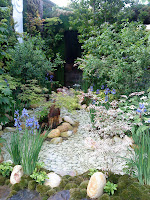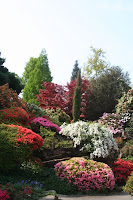 W
When I was teaching garden history at Birkbeck, one of the first things students had to do was complete a questionnaire. The most interesting question for me was why they were taking the course. There were the expected boxes to tick – to gain a further qualification (Certificate in Garden History), career development – but the most popular, and my favourite, was ‘purely for pleasure’.
(Woodcut from Thomas Hill's 'Most Briefe and Pleasaunt Treatyse, Teachynge How to Dresse, Sowe, and set a Garden', 1558)
The last time I taught the Introduction to Garden History, the venue was the London School of Economics, near Aldwych. The class was full – over 25 – and the majority ticked ‘purely for pleasure’. A great crowd. The course ran from September till March – all through what was quite a grim winter, and it amazed me that people would turn up to an evening class in blizzards, driving rain and various degrees of miserable meteorological conditions, even the weeks before Christmas and after New Year, when I have to admit that, on particularly bleak nights, my main motivating factor for turning up was that, if I cancelled, I’d have to run an extra session at the end of the year. (I only missed one session in two years when, on the train from Brighton, a fallen log held us immobile for 2 ½ hours somewhere near Haywards Heath before we had to turn back. Luckily, I had a good book, and, when it became clear it would be impossible to make it, I called Michael Symes, the programme director, and creator of the first garden history courses at Birkbeck, to apologise, he gallantly said he was sorry I’d had such an awful journey: also, there was a convivial group of homeward-bound businessmen who made the most of the buffet car’s facilities during the hold-up. When one of them tried to phone his wife to say he'd be late back because there was a log on the line, his friends joked about leaves on the line – as possibly unlikely excuses, at least it was a new one).
Yet when I got there each time, the beautiful garden images and their stories (not to mention those lovely students . . . ) made me forget everything else. And, of course, it was always spring or summer there [below right, cowslips from Leonhart Fuchs's herbal of 1542, 'De Historia Stirpium'].

There were students of all ages and histories on the introductory course – one or two in their twenties were in training as garden designers or horticulturalists, and all were enthusiastic gardengoers. But what stood out from that first session was when, after I'd shown the most tempting and tantalising slides I could find, as advised by my programme director, so as to transport my audience (some of whom were still prospecting, not having registered yet) on what I hoped was an irresistibly enticing whirlwind tour of the world’s gardens from Ancient Babylon to the eighteenth century, I asked my students why they were doing the course. Memorably, one of the youngest students, who was training to be a garden designer, said he didn’t have a garden so he was taking the course to enjoy ‘virtual gardens’.
At the time, I was living in Croydon and going to yoga classes at the local Buddhist centre – and, reading up on yogic philosophy a little, became interested in one of many forms of meditation, positive visualisation - projecting beautiful images on to your mind, maybe a lake, a forest, the sea, a garden. I wondered if showing images of gardens was the same kind of thing, except with slides as props.
Far Other Worlds

I recently gave a talk at the Cheltenham Music Festival – apart from the pleasure of being invited, a main draw was that this was a pre-concert talk for a performance by the Musicians of the Globe. It was a perfect summer's day, and the elegant Pittville Pump Room surrounded by a sea of lawn made a sumptuous venue. One of the interesting things about the programme was that almost half the composers were anonymous; song titles tended to celebrate much-loved and emblematic flowers of the era - ‘Sweet Bryer/Eglantine’, ‘The Gilleyflower', ‘The Honi-suckle’, ‘The Marigold’. My favourite piece was ‘Thyrsis and Milla’ by Thomas Morley; it was also lovely to hear such a well-known poem as Thomas Campion’s ‘There is a garden in her face’ set to music by Robert Jones [below right, wood engraving of Elizabeth encircled by Tudor roses and eglantine, 1588].

I knew little about Elizabethan music beyond a few compilation CDs and the songs of John Dowland as blazingly reinterpreted by Sting and Bosnian lutenist Edin Karamazov in ‘Songs from the Labyrinth’ (2006). In the concert in the Pittville Pump Room, ‘All in a Garden Green’, I was unexpectedly captivated by one of the last songs in the performance on the most famous of all garden poems, Marvell’s ‘The Garden’, arranged by an anonymous composer. It was particularly striking how the composer repeated a line about the ‘garlands of repose’. Director Philip Pickett and his musicians played with extraordinary vigour and control; soprano Joanne Lunn was superb.

The high point of ‘The Garden’ is just the blissful experience of being there: ‘Annihilating all that's made/To a green thought in a green shade’. That single couplet alone has made Marvell the patron saint of garden poets ('Stumbling on melons as I pass,/ Insnared with flowers, I fall on grass' has also won him a few fans . . . ) [Painting, above right: Juan Sánchez Cotán, 'Quince, Cabbage, Melon
and Cucumber', 1602] But till now I hadn’t clued into the lines that come directly before this: in Marvell’s ‘happy garden-state’, the mind transcends itself and creates ‘far other worlds, and other seas/ Annihilating all that's made /To a green thought in a green shade’.
Taking a journey with Marvell to your own ‘far other worlds’ compares to Keats’s travels in the ‘realms of gold’ on first reading Chapman’s Homer; imaginative exploration packs a punch. And Paul McKenna has described how, as far as impressions go, the nervous system responds as strongly to what it imagines as to real events, giving an insight into the power of books, films and, of course, hypnosis. Not to mention virtual gardengoing . . . (which brings to mind Bill Burroughs' concept of the writer as an 'astronaut of inner space' - and reading as a creative activity.)
Next routine (I promise!): Japanese gardens at Chelsea, Open Garden Squares Weekend, Leonardslee and Preston Park, Brighton













